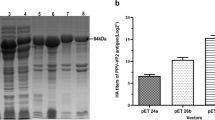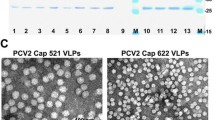Abstract
Porcine circovirus type 2 (PCV2) is a ubiquitous virus with high pathogenicity closely associated with the postweaning multisystemic wasting syndrome (PMWS) and porcine circovirus diseases (PCVDs), which caused significant economic losses in the swine industry worldwide every year. The PCV2 virus-like particles (VLPs) are a powerful subunit vaccine that can elicit high immune response due to its native PCV2 virus morphology. The baculovirus expression system is the widely used platform for producing commercial PCV2 VLP vaccines, but its yield and cost limited the development of low-cost vaccines for veterinary applications. Here, we applied a nonconventional yeast Kluyveromyces marxianus to enhance the production of PCV2 VLPs. After codon optimization, the PCV2 Cap protein was expressed in K. marxianus and assemble spontaneously into VLPs. Using a chemically defined medium, we achieved approximately 1.91 g/L of PCV2 VLP antigen in a 5-L bioreactor after high cell density fermentation for 72 h. That yield greatly exceeded to recently reported PCV2 VLPs obtained by baculovirus-insect cell, Escherichia coli and Pichia pastoris. By the means of two-step chromatography, 652.8 mg of PCV2 VLP antigen was obtained from 1 L of the recombinant K. marxianus cell culture. The PCV2 VLPs induced high level of anti-PCV2 IgG antibody in mice serums and decreased the virus titers in both livers and spleens of the challenged mice. These results illustrated that K. marxianus is a powerful yeast for cost-effective production of PCV2 VLP vaccines.





Similar content being viewed by others
References
Alegria-Schaffer A (2014) Western blotting using chemiluminescent substrates. Methods Enzymol 541:251–259
Allan G, Krakowka S, Ellis J, Charreyre C (2012) Discovery and evolving history of two genetically related but phenotypically different viruses, porcine circoviruses 1 and 2. Virus Res 164:4–9
Antunes DF, de Souza CG, de Morais MA (2000) A simple and rapid method for lithium acetate-mediated transformation of Kluyveromyces marxianus cells. World J Microbiol Biotechnol 16:653–654
Bucarey SA, Noriega J, Reyes P, Tapia C, Saenz L, Zuniga A, Tobar JA (2009) The optimized capsid gene of porcine circovirus type 2 expressed in yeast forms virus-like particles and elicits antibody responses in mice fed with recombinant yeast extracts. Vaccine 27:5781–5790
Cai XP, Zhang J, Yuan HY, Fang ZA, Li YY (2005) Secretory expression of heterologous protein in Kluyveromyces cicerisporus. Appl Microbiol Biotechnol 67:364–369
Chae C (2005) A review of porcine circovirus 2-associated syndromes and diseases. Vet J 169:326–336
Chen Y, Zhang Y, Quan C, Luo J, Yang YL, Yu MR, Kong YJ, Ma GH, Su ZG (2015) Aggregation and antigenicity of virus like particle in salt solution-a case study with hepatitis B surface antigen. Vaccine 33:4300–4306
Cheung AK, Bolin SR (2002) Kinetics of porcine circovirus type 2 replication. Arch Virol 147:43–58
Cruz TF, Magro AJ, de Castro A, Pedraza-Ordonez FJ, Tsunemi MH, Perahia D, Araujo JP Jr (2018) In vitro and in silico studies reveal capsid-mutant porcine circovirus 2b with novel cytopathogenic and structural characteristics. Virus Res 251:22–33
Ding Y, Chuan YP, He LZ, Middelberg APJ (2010) Modeling the competition between aggregation and self-sssembly during virus-like particle processing. Biotechnol Bioeng 107:550–560
Fachinger V, Bischoff R, Ben Jedidia S, Saalmuller A, Elbers K (2008) The effect of vaccination against porcine circovirus type 2 in pigs suffering from porcine respiratory disease complex. Vaccine 26:1488–1499
Finlay BB, McFadden G (2006) Anti-immunology: evasion of the host immune system by bacterial and viral pathogens. Cell 124:767–782
Firth C, Charleston MA, Duffy S, Shapiro B, Holmes EC (2009) Insights into the evolutionary history of an emerging livestock pathogen: porcine circovirus 2. J Virol 83:12813–12821
Franzo G, Cortey M, Segales J, Hughes J, Drigo M (2016) Phylodynamic analysis of porcine circovirus type 2 reveals global waves of emerging genotypes and the circulation of recombinant forms. Mol Phylogenet Evol 100:269–280
Gibson DG, Young L, Chuang RY, Venter JC, Hutchison CA, Smith HO (2009) Enzymatic assembly of DNA molecules up to several hundred kilobases. Nat Methods 6:343–U341
Gillespie J, Opriessnig T, Meng XJ, Pelzer K, Buechner-Maxwell V (2009) Porcine circovirus type 2 and porcine circovirus-associated disease. J Vet Intern Med 23:1151–1163
Groeneveld P, Stouthamer AH, Westerhoff HV (2009) Super life - how and why 'cell selection' leads to the fastest-growing eukaryote. FEBS J 276:254–270
Hamel AL, Lin LL, Nayar GPS (1998) Nucleotide sequence of porcine circovirus associated with postweaning multisystemic wasting syndrome in pigs. J Virol 72:5262–5267
Hensing M, Vrouwenvelder H, Hellinga C, Baartmans R, Vandijken H (1994) Production of extracellular inulinase in high-cell-density fed-batch cultures of Kluyveromyces marxianus. Appl Microbiol Biotechnol 42:516–521
Jiang CG, Wang G, Tu YB, Liu YG, Wang SJ, Cai XH, An TQ (2017) Genetic analysis of porcine circovirus type 2 in China. Arch Virol 162:2715–2726
Jin JY, Park CH, Cho SH, Chung JH (2018) The level of decoy epitope in PCV2 vaccine affects the neutralizing activity of sera in the immunized animals. Biochem Biophys Res Commun 496:846–851
Kiupel M, Stevenson GW, Choi J, Latimer KS, Kanitz CL, Mittal SK (2001) Viral replication and lesions in BALB/c mice experimentally inoculated with porcine circovirus isolated from a pig with postweaning multisystemic wasting disease. Vet Pathol 38:74–82
Liu QG, Tikoo SK, Babiuk LA (2001) Nuclear localization of the ORF2 protein encoded by porcine circovirus type 2. Virology 285:91–99
Liu J, Chen I, Kwang J (2005) Characterization of a previously unidentified viral protein in porcine circovirus type 2-infected cells and its role in virus-induced apoptosis. J Virol 79:8262–8274
Liu J, Chen I, Du QY, Chua HK, Kwang J (2006) The ORF3 protein of porcine circovirus type 2 is involved in viral pathogenesis in vivo. J Virol 80:5065–5073
Liu YK, Zhang YY, Yao LG, Hao HF, Fu XJ, Yang ZQ, Du EQ (2015) Enhanced production of porcine circovirus type 2 (PCV2) virus-like particles in Sf9 cells by translational enhancers. Biotechnol Lett 37:1765–1771
Lopez-Vidal J, Gomez-Sebastian S, Barcena J, Nunez MD, Martinez-Alonso D, Dudognon B, Guijarro E, Escribano JM (2015) Improved production efficiency of virus-like particles by the baculovirus expression vector system. PLoS One 10:e0140039
Lua LHL, Connors NK, Sainsbury F, Chuan YP, Wibowo N, Middelberg APJ (2014) Bioengineering virus-like particles as vaccines. Biotechnol Bioeng 111:425–440
Lv QZ, Guo KK, Wang T, Zhang CC, Zhang YM (2015) Porcine circovirus type 2 ORF4 protein binds heavy chain ferritin. J Biosci (Bangalore) 40:477–485
Marcekova Z, Psikal I, Kosinova E, Benada O, Sebo P, Bumba L (2009) Heterologous expression of full-length capsid protein of porcine circovirus 2 in Escherichia coli and its potential use for detection of antibodies. J Virol Methods 162:133–141
Masuda A, Lee JM, Miyata T, Sato T, Hayashi S, Hino M, Morokuma D, Karasaki N, Mon H, Kusakabe T (2018) Purification and characterization of immunogenic recombinant virus-like particles of porcine circovirus type 2 expressed in silkworm pupae. J Gen Virol 99:917–926
Misinzo G, Meerts P, Bublot M, Mast J, Weingart HM, Nauwynck HJ (2005) Binding and entry characteristics of porcine circovirus 2 in cells of the porcine monocytic line 3D4/31. J Gen Virol 86:2057–2068
Nainys J, Lasickiene R, Petraityte-Burneikiene R, Dabrisius J, Lelesius R, Sereika V, Zvirbliene A, Sasnauskas K, Gedvilaite A (2014) Generation in yeast of recombinant virus-like particles of porcine circovirus type 2 capsid protein and their use for a serologic assay and development of monoclonal antibodies. BMC Biotechnol 14:100
Nawagitgul P, Morozov I, Bolin SR, Harms FA, Sorden SD, Paul PS (2000) Open reading frame 2 of porcine circovirus type 2 encodes a major capsid protein. J Gen Virol 81:2281–2287
Opriessnig T, Xiao CT, Gerber PF, Halbur PG (2013) Emergence of a novel mutant PCV2b variant associated with clinical PCVAD in two vaccinated pig farms in the US concurrently infected with PPV2. Vet Microbiol 163:177–183
Opriessnig T, Xiao CT, Halbur PG, Gerber PF, Matzinger SR, Meng XJ (2017) A commercial porcine circovirus (PCV) type 2a-based vaccine reduces PCV2d viremia and shedding and prevents PCV2d transmission to naive pigs under experimental conditions. Vaccine 35:248–254
Phan TG, Giannitti F, Rossow S, Marthaler D, Knutson TP, Li L, Deng X, Resende T, Vannucci F, Delwart E (2016) Detection of a novel circovirus PCV3 in pigs with cardiac and multi-systemic inflammation. Virol J 13:184
Puigbo P, Guzman E, Romeu A, Garcia-Vallve S (2007) OPTIMIZER: a web server for optimizing the codon usage of DNA sequences. Nucleic Acids Res 35:W126–W131
Ren LZ, Chen XR, Ouyang HS (2016) Interactions of porcine circovirus 2 with its hosts. Virus Genes 52:437–444
Rouwenhorst RJ, Visser LE, Vanderbaan AA, Scheffers WA, Vandijken JP (1988) Production, distribution, and kinetic-properties of inulinase in continuous cultures of Kluyveromyces marxianus CBS 6556. Appl Environ Microbiol 54:1131–1137
Shi L, Sanyal G, Ni A, Luo Z, Doshna S, Wang B, Graham TL, Wang N, Volkin DB (2005) Stabilization of human papillomavirus virus-like particles by non-ionic surfactants. J Pharm Sci 94:1538–1551
Steppert P, Burgstallera D, Klausberger M, Tover A, Berger E, Jungbauer A (2017) Quantification and characterization of virus-like particles by size-exclusion chromatography and nanoparticle tracking analysis. J Chromatogr 1487:89–99
Summers MD (2006) Milestones leading to the genetic engineering of baculoviruses as expression vector systems and viral pesticides. Adv Virus Res 68:3–73
Tischer I, Rasch R, Tochtermann G (1974) Characterization of papovavirus-and picornavirus-like particles in permanent pig kidney cell lines. Zentralbl Bakteriol Orig A 226:153–167
Tischer I, Gelderblom H, Vettermann W, Koch MA (1982) A very small porcine virus with circular single-stranded-DNA. Nature 295:64–66
Trible BR, Suddith AW, Kerrigan MA, Cino-Ozuna AG, Hesse RA, Rowland RR (2012) Recognition of the different structural forms of the capsid protein determines the outcome following infection with porcine circovirus type 2. J Virol 86:13508–13514
Trundova M, Celer V (2007) Expression of porcine circovirus 2 ORF2 gene requires codon optimized E. coli cells. Virus Genes 34:199–204
Tu YB, Wang YQ, Wang G, Wu JN, Liu YG, Wang SJ, Jiang CG, Cai XH (2013) High-level expression and immunogenicity of a porcine circovirus type 2 capsid protein through codon optimization in Pichia pastoris. Appl Microbiol Biotechnol 97:2867–2875
Ulmer JB, Valley U, Rappuoli R (2006) Vaccine manufacturing: challenges and solutions. Nat Biotechnol 24:1377–1383
Wu PC, Lin WL, Wu CM, Chi JN, Chien MS, Huang CJ (2012) Characterization of porcine circovirus type 2 (PCV2) capsid particle assembly and its application to virus-like particle vaccine development. Appl Microbiol Biotechnol 95:1501–1507
Wu PC, Chen TY, Chi JN, Chien MS, Huang CJ (2016) Efficient expression and purification of porcine circovirus type 2 virus-like particles in Escherichia coli. J Biotechnol 220:78–85
Yang X, Chen FW, Cao YH, Pang DX, Ouyang HS, Ren LZ (2013) Comparative analysis of different methods to enhance porcine circovirus 2 replication. J Virol Methods 187:368–371
Yu C, Li X, Liu JW, Diao WZ, Zhang LC, Xiao Y, Wei HF, Yu YL, Yu YQ, Wang LY (2016) Replacing the decoy epitope of PCV2b capsid protein with a protective epitope enhances efficacy of PCV2b vaccine. Vaccine 34:6358–6366
Zaveckas M, Snipaitis S, Pesliakas H, Nainys J, Gedvilaite A (2015) Purification of recombinant virus-like particles of porcine circovirus type 2 capsid protein using ion-exchange monolith chromatography. J Chromatogr B 991:21–28
Author information
Authors and Affiliations
Corresponding authors
Ethics declarations
Funding
This study was supported by the projects of National Natural Science Foundation of China (31770094 and 91731310), National High Technology Research and Development Program of China (2014AA021301), Science and Technology Research Program of Shanghai (18391901800) and Open Research Funds of the State Key Laboratory of Genetic Engineering, Fudan University.
Conflict of interest
The authors declare that they have no competing interests.
Ethical approval
All the mice experimental procedures were approved by the Animal Experiment Committee of Fudan University. All applicable international, national, and institutional guidelines for the care and use of animals were strictly followed.
Rights and permissions
About this article
Cite this article
Duan, J., Yang, D., Chen, L. et al. Efficient production of porcine circovirus virus-like particles using the nonconventional yeast Kluyveromyces marxianus. Appl Microbiol Biotechnol 103, 833–842 (2019). https://doi.org/10.1007/s00253-018-9487-2
Received:
Revised:
Accepted:
Published:
Issue Date:
DOI: https://doi.org/10.1007/s00253-018-9487-2




